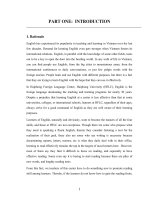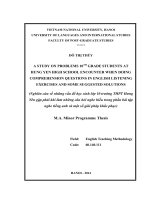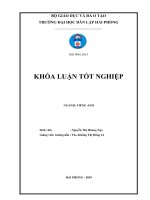the difficulties of non-major of english at haiphong foreign language center–haiphong university in learning listening skill and some suggested solutions = những khó khăn của sinh viên không chuyên anh
Bạn đang xem bản rút gọn của tài liệu. Xem và tải ngay bản đầy đủ của tài liệu tại đây (945.4 KB, 62 trang )
VIETNAM NATIONAL UNIVERSITY, HANOI
UNIVERSITY OF LANGUAGES AND INTERNATIONAL STUDIES
FACULTY OF POST - GRADUATE STUDIES
PHẠM THỊ PHƯỢNG
THE DIFFICULTIES OF NON - MAJOR STUDENTS OF ENGLISH AT
HAIPHONG FOREIGN LANGUAGE CENTER - HAIPHONG UNIVERSITY
IN LEARNING LISTENING SKILL AND SOME SUGGESTED SOLUTIONS
NHỮNG KHÓ KHĂN CỦA SINH VIÊN KHÔNG CHUYÊN ANH TẠI TRUNG
TÂM NGOẠI NGỮ - ĐẠI HỌC HẢI PHÕNG TRONG VIỆC HỌC KỸ NĂNG
NGHE VÀ MỘT SỐ GIẢI PHÁP ĐỀ XUẤT
M.A.MINOR PROGRAMME THESIS
Field: English Teaching Methodology
Code: 60140111
HANOI - 2014
VIETNAM NATIONAL UNIVERSITY, HANOI
UNIVERSITY OF LANGUAGES AND INTERNATIONAL STUDIES
FACULTY OF POST - GRADUATE STUDIES
PHẠM THỊ PHƯỢNG
THE DIFFICULTIES OF NON - MAJOR STUDENTS OF ENGLISH AT
HAIPHONG FOREIGN LANGUAGE CENTER - HAIPHONG UNIVERSITY
IN LEARNING LISTENING SKILL AND SOME SUGGESTED SOLUTIONS
NHỮNG KHÓ KHĂN CỦA SINH VIÊN KHÔNG CHUYÊN ANH TẠI TRUNG
TÂM NGOẠI NGỮ - ĐẠI HỌC HẢI PHÕNG TRONG VIỆC HỌC KỸ NĂNG
NGHE VÀ MỘT SỐ GIẢI PHÁP ĐỀ XUẤT
M.A.MINOR PROGRAMME THESIS
Field: English Teaching Methodology
Code: 60140111
Supervisor: Prof. Dr. Hoàng Văn Vân
HANOI - 2014
i
DECLARATION
Honestly, the thesis has been resulted from my own research. Therefore, all the
statistic given must be reliable. Moreover, all the reference information was quoted
or summarized with the clear original sources which have been shown in the
references part.
I truthfully assure that the thesis has been completed by myself.
Hanoi, 2014
Phạm Thị Phượng
ii
ACKNOWLEDGEMENTS
First of all, I would like to send my deepest gratitude to my supervisor, Prof.
Dr. Hoàng Văn Vân, who guided me throughout the accomplishment of this research.
If it had not been for his kind guidance, insightful comments and valuable support, my
thesis would not have been completed.
I also owe my gratitude to my family, who has always been very supportive
with my study.
In addition, I am grateful to all my colleagues and students at Haiphong Foreign
Language Center, who have encouraged me and shared me useful information. Their
cooperation helped me a lot to finish the thesis.
Personally, I highly appreciate all the assistance. I am greatly interested in this
study as it is of great help for me. However, I am responsible for any remaining
mistakes and short comings that are found in this work.
iii
ABSTRACT
Listening skill is one of the most neccessary skills to communicate in the real
life. In learning a foreign language, it is more and more important to learn this skill. In
fact, students often take the wrong way when listening and this leads them to the poor
result. Realizing the problems from teaching experiences, the author would like to do a
research titled “The difficulties of non-major students of English at Haiphong
Foreign Language Center-Haiphong University in learning listening skill and some
suggested solutions
This study is an investigation into the problems experienced by non-major
students of English at Haiphong Foreign Language Center-Haiphong University in
learning listening skill. The subjects of the study were 75 non-English major students
and 5 teachers at Haiphong Foreign Language Center (HFLC)-Haiphong University.
The data were collected through the questionnaires from students, and the interviews
from the teachers.
The results of the research will point out the difficulties that learners meet when
they learn the listening skill at HFLC. More importantly, it helps the author find out
the causes of those difficulties so that she can work out the right solutions to the
problems. With the hope of improving learners‟ listening competence, the author has
tried her best to do this thesis by her own experiences and knowledge in English
teaching methodology.
The findings of the research will reveal the difficulties that learners experience
when they learn the listening skill at the center. Some conclusions were drawn;
recommendations were made, some limitations were pointed out and suggestions were
offered.
iv
LIST OF FIGURES
Figure 3.1: Purposes of learning English at HFLC
Figure 3.2: Learners' time distribution in practicing four language skills
Figure 3.3: Students‟ attitude toward listening skill
Figure 3.4: Students‟ time allocation for self-study
Figure 3.5: What the learners do before and while listening
Figure 3.6: Learners‟ assessment on the listening tasks in the textbook
Figure 3.7: Learners‟ interest in different listening activities
Figure 3.8: Learners‟ interest in extra listening activities
Figure 3.9: The objective factors affecting learners' learning the listening skill
Table 1: Problems from the listeners
Table 2: Problems from the listening material
Table 3: Problems from environment factors
v
TABLE OF CONTENTS
Page
Table of Contents i
Declaration iv
Acknowledgements v
Abstract vi
List of Figures and Tables vii
PART I:INTRODUCTION 1
1 Rationale 1
2. Aim of the study and research questions 1
3. The Scope of the study 2
4. The method of the study 2
5. The organization of the study 3
PART II:DEVELOPMENT 4
Chapter 1: LITERATURE REVIEW 4
1.1 What are listening and listening skill 4
1.1.1 Definitions 4
1.1.2. The importance of the listening skill 5
1.1.3. Potential difficulties in listening skill 6
1.1.3.1. Listening problems 6
1.1.3.2. Language problems 9
CHAPTER 2: METHODOLOGY 11
2.1. An overview of the current situations of teaching and learning the
English listening skill at Haiphong Foreign Language Center 11
2.1.1. Introduction 11
vi
2.1.2. Resources and materials 11
2.1.3. Teachers and Teaching methods 13
2.2. Data collection. 13
2.2.1. Participants 14
2.2.2. Data collection instruments 14
CHAPTER 3: DATA ANALYSIS AND FINDINGS 15
3.1. Intended research contents 15
3.1.1. Purposes to learn English at HFLC 15
3.1.2. Students‟ attitude toward listening skill 16
3.1.3. Students‟ strategies in listening 18
3.1.4. Learners‟ assessment on the listening task in the text book 20
3.1.5. Problems experienced by learners in learning English listening
skill 23
3.1.5.1. Problems from listeners 23
3.1.5.2. Problems from the listening materials 25
3.1.5.3. Problems from environment factors 27
3.2. Summary 30
3.3. Suggested solution improving the teaching of English listening
skill to learners at Haiphong Foreign Language Center 32
3.3.1. Recommendations for teaching English listening skill for non-
major students at HFLC 32
3.3.1.1. Improving teacher‟s classroom techniques 33
3.3.1.2. Training students to become active listeners 34
3.3.1.3. Developing the listening materials 36
3.3.1.3.1. Adapting and improving listening materials 36
vii
3.3.1.3.2. Choosing supplementary listening materials 37
3.3.1.4. Improving teaching facilities and resources 37
3.3.1.5. Other problematic areas 37
3.4. Summary 38
PART III: CONCLUSION 39
1. Recapitulation 39
2. Conclusions 39
3. Limitations of the study 40
4. Suggestions for further study 40
REFERENCES 41
APPENDICES I
1
PART I
INTRODUCTION
1. Rationale
Listening plays a significant role in daily communication. No one can deny the
importance of listening skill in foreign language learning because it takes much time
and energy to make progress in this skill. Listening plays an important role in
communication. It is said that of the total time spent on communicating, listening takes
up 40-50%. According to Devine (1982), listening is the primary means by which
incoming ideas and information are taken in.
Being good at communicators in foreign languages especially in English is
always a desire of all foreign language learners. However, it requires them to speak
and to listen well in which listening is considered the most challenging skill for every
learner. In fact, there are many factors affecting the learners in listening acquisition.
They may come from the listeners (their background knowledge, their interest or their
motivation…), from the listening material or from the environment factors.
Consequently, it is very difficult for them to master this skill.
With thirteen-year experience of teaching English listening skill at Haiphong
Foreign Language Center and from what I observed many classes at HFLC, it can be
found that many students failed in practicing listening skill. Some of the students
complained that they were not confident with listening tasks so they could hardly
understand the spoken messages
Realizing the problem from teaching experiences, I have decided to carry out a
study namely “The difficulties of non-major students of English at Haiphong
Foreign Language Center-Haiphong University in learning listening skill and some
suggested solutions”.
2. Aim of the study and research questions
The aim of the study is to probe difficulties experienced by students at
Haiphong Foreign Language Center (HFLC) in learning listening skill and to offer
solutions to help students overcome these difficulties.
2
To achieve this overall aim, the following research questions are raised for
exploration:
1. What are the problems experienced by learners in learning English listening
skill at HFLC?
2. How can the teacher help learners overcome the difficulties?
3. Scope of the study
The study is limited to finding out the difficulties that the learners at HFLC
cope with in learning English listening skill.
The objects of the study are the learners at HFLC aged from 15 to over 50.
They are studying the second of three levels of English at HFLC. In this center, the
textbook that the learners use is New English File-Pre intermediate (Clive Oxenden,
Christina Latham-Koenig, Paul Seligson). This textbook is intended to develop
learners‟ four skills: listening, speaking, reading and writing.
4. Method of the study
To fulfill the above aim, both qualitative and quantitative methods are used.
Qualitative research is “a type of scientific research which consists of an
investigation that seeks answers to a question, systematically uses a predefined set of
procedures to answer the question, collects evidence, produces findings that were not
determined in advance, produces findings that are applicable beyond the immediate
boundaries of the study” (Trask, 2007, p.239).
The most common qualitative methods are participant observation, in-depth
interviews, and focus groups. In order to get information about learners‟ motivation
when they learn English listening skill at HFLC, the author has to observe their study
in the real classes. Moreover, interviews are used for the teachers of English so as to
get their ideas about the teaching and learning problems at HFLC.
According to Aliaga and Gunderson (2000) “Quantitative research is
explaining phenomena by collecting numerical data that are analyzed using
mathematically based methods (in particular statistics)”
In this study, the author uses questionnaires for learners to get information
about teaching and learning listening skill at HFLC.
3
After collecting information, all the data will be analyzed for the findings and
conclusions will be drawn from these.
5. Organization of the study
The study includes three parts as follows:
Part I: The Introduction presents the background, the aim, the scope and the
method of the study.
Part II: The Development consists of three chapters. Chapter 1 is the literature
review which provides an overview of some theories as well as the previous researches
that relate to the study. Chapter 2, the methodology and findings describes the current
situation of teaching and learning listening skill at HFLC. Then it will introduce the
participants, the data collection instruments, data analysis and research questions.
Finally, the author will analyze the results of the survey and the interviews in order to
find out the current state of learning listening skill at HFLC. Chapter 3 offers some
solutions to improve learning English listening skill for learners at HFLC.
Part III: The Conclusion summarizes what has been studied and makes some
recommendations for further research.
4
PART II
DEVELOPMENT
CHAPTER 1: LITERATURE REVIEW
Listening plays an important role in second language instruction for several
reasons. If you cannot hear it well you will find it hard to communicate or perhaps you
cannot pass your listening examination (Rost, 1994) It should be noted that the
learner‟s perception of their listening problem and strategies can affect their
comprehension both positively and negatively (Wenden, 1986). Thus, in order to help
students improve their listening skill, it is necessary to find out their listening
problems, what cause them and how to solve them.
1.1. What are listening and listening skill?
1.1.1. Definitions
In this study, listening is listening comprehension. It is a significant and
essential area of development in a native language and in a second language.
Therefore, there have been many definitions of listening.
Gary Buck (2001: 31), for example, points out that “listening comprehension is
an active process of constructing meaning and this is done by applying knowledge to
the incoming sound” in which “a number of different types of knowledge are involved:
both linguistic knowledge and non-linguistic knowledge”.
On the other hand, Wolvin and Coakley (1985) see listening as “the process of
receiving, attending to and assigning meaning to aural stimuli”.
According to Brown (2001), listening is “not merely the process of
unidirectional receiving of audible symbols”. He supposed that one aspect of listening
comprehension which is “the psychomotor process of receiving sound waves through
the ear and transmitting nerve impulses to the brain”. Hence, listening comprises of
three elements: the sender, the message and the listener.
It can be concluded from the above mentioned definitions that listening skill
can be understood as “the ability to identify and understand what others are saying.
This involves understanding a speaker‟s accent or pronunciation, understanding his
5
grammar, recognizing his vocabulary and being able to grasp the meaning of what he
says.” (Howatt and Dakin,1974).
1.1.2. The importance of listening skill
Listening is a skill that is important because it helps us learn and understand
different things. Usually, a person who listens properly is able to react appropriately to
a particular situation or towards a particular person. Everyone, in the real life, often
listens more than speaks, reads or writes. We listen everywhere and every time. We
listen to everything and everybody.
There are differences between hearing and listening. While hearing is a part of
five senses (hearing, smelling, tasting, touching and looking) listening is a choice to
hear and understand it. As an integrative skill, listening plays an important role in the
process of language learning or acquisition and facilitating the emergence of other
language skill. According to Nord (1980: 17), listening is the way of learning the
language. “It gives the learner information from which to build up the knowledge
necessary for using the language. When this knowledge is built up, the learner can
begin to speak. “The listening period is a time of observation and learning which
provides the basis for the other language skills” (Nation, 1990: 12). Most learners will
spend more time listening to the foreign language than producing it themselves.
Failing to understand spoken language, people may miss important information
presented to them or respond in a funny way. So training in listening is really
necessary. It helps students make the transition from classroom English to the real-life
English more easily and effectively.
From the point of view of psychology, listening is a necessary skill to facilitate
autonomous learning and encourage learners‟ independence. Listening is also an
important form of communication. This is the reason why “We were given two ears
but only one month; this is because God knew that listening was twice as hard as
talking”. People need to practice and acquire skills to be good listeners.
1.1.3. Potential difficulties in listening skill
1.1.3.1. Listening problems
6
In her book entitled Teaching Listening, Mary Underwood (1989), points out
the following listening problems:
* Lack of control over the speech at which speakers speak
This means the learners cannot control how quickly the speaker speaks. They
feel that the utterances disappear before they can sort them out. “They are so busy
working out the meaning of one part of what they hear that they miss the next part. Or
they simply ignore a whole chunk because they fail to sort it all out quickly enough”.
One of the reasons for this is that learners cannot keep up with the speech and they
often try to understand everything they hear. When they fail in sorting out the meaning
of one part, their following will be missed. This can lead to the ignorance of the whole
chunk of discourse. Obviously, they fail to listen. One method of tackling this is to
show students how to identify the important words that they need to listen out for. In
English this is shown in an easy-to-spot way by which words in the sentence are
stressed (spoken louder and longer). Another is to give them one very easy task that
you know they can do even if they do not get 90% of what is being said to build up
their confidence, such as identifying the name of the famous person or spotting
something that is mentioned many times.
* The listener’s vocabulary
This is the main problem of the learners in listening comprehension. It is very
difficult to understand the spoken text if we do not know the new words. According to
Underwood (Ibid.), “unknown word can be like a suddenly dropped barrier causing
them to stop and think about the meaning of the word and thus making them miss the
text part of the speech”. There are four situations relating to the vocabulary that the
learners usually committed. These situations are presented below:
(1) Trying to understand every word. In spite of the fact that they can hope
with missing whole chunks of speech having conversation on a noisy street in our own
language, many people do not seem to be able to transfer that skill easily to a second
language.
7
(2) Getting left behind trying to work out what a previous word meant. All
people speaking a foreign language have experienced this problem at one or more than
one time. This often happens when you hear a word half. However, it also can happen
with words you are trying to work out that sound similar to something in your
language. In individual listening you can cut down on this problem with vocabulary
pre-teach and by getting students to talk about the same topic first to bring the relevant
vocabulary for that topic area nearer the front of their brain. One training method is to
use a listening or to get them to concentrate just on guessing words from context.
Another is to load up the task even more by adding a logic puzzle or listening and
writing task, so that just listening and try to remember words seems like an easier
option. Finally, spending time revising vocabulary and doing skills work where they
come into contact with it and use it.
(3) Not knowing the most important words. Doing the vocabulary pre-teaching
before each listening is an effective solution. Nevertheless, these words must actually
be guessed from the context. The other solution is simply to build up their vocabulary
and teach them how they can do the same in their own time with vocabulary lists,
graded readers, monolingual dictionary use, etc.
(4) Not recognizing the words that have been known. The common reasons
why students might not recognize the words include not distinguish between different
sounds in English, or conversely trying to listen for differences that do not exist. Other
reasons are problems with word stress, sentence stress, and sound changes when words
are spoken together in natural speech such as weak forms. What all this boils down to
is that sometimes pronunciation work is the most important part of listening
comprehension skills building.
* Inability to concentrate
This can be caused by a number of things but in listening work it is a major
problem because even the shortest break in attention can seriously impair the
comprehension of the whole process of listening. Whether the topic is interesting or
not, students sometimes find tired and unable to concentrate. The outside factors may
8
well make concentration difficult, too. For instance the bad quality machines, poor
recording, unfavorable rooms for the use of recorded materials, street or next-door
class noise…all of these facts prevent strongly to the concentration of the result, they
cannot get full of the message intended.
* Not being able to catch information repeated
This type of difficulty connects with what the speakers say or “input” while the
listeners are not always in the positions to get the repetition. This is the case when
learners join in conversation outside the classroom. Repetition cannot be asked for
when listening to the radio or watching television. Even in the classroom, when
listening to the lectures, learners cannot frequently order the lecturers to repeat the
utterance as many times as they wish. Therefore, the teacher can be solved only when
learners are given the opportunity to control their own machines and proceed in
whatever way they wish.
* Problems of interpretation
These can occur when the speaker and the listener are from the different
background and the listener is unfamiliar with the context of speaker‟s talk. Students
who are unfamiliar with the context may have considerable difficulty in interpreting
the words they hear even if they can understand the “surface” meaning. In addition, the
meaning of non-verbal clues, facial expression, nods, gestures, tone of voice can easily
be misinterpreted by listeners from other cultures. This problem can even occur when
the speaker and the hearer are from the same background and use the same language.
* Established learning habits
Learning habit is an important factor leading to the success of language
learning. If students establish wrong habits, they may fail in their learning, etc. In
different point of view, Goh,C (2000) states that problems in listening comprehension
depend on three stages which will be presented as follows:
9
Perception stage
At this stage, students do not recognize the words they know, neglect the next
part when thinking about meaning, cannot chunk steams of speech, miss the beginning
of the text and unable to concentrate.
Parsing stage
At this stage, students quickly forget what is heard, unable to form a mental
representation from these words, and do not understand subsequent parts of input
because of earlier problems.
Utilization stage
At this stage students understand the words but not the intended messages,
confused about the key ideas in the messages.
1.1.3.2. Language problems
Anne Anderson and Tony Lynch (1988: 37) point out that problems in listening
comprehension encountered by L2 learners created by primarily linguistic knowledge
though language system may not always be the principal cause of comprehension
difficulty. They explain that one obvious way in which input can be more or less
complex is in terms of syntactic structures for ESL learners. It is understandable as
learners adopt a target language that possesses certain characteristics of ESL far
different from their native one in terms of grammatical structures, lexicon, vocabulary
and its mechanism meanwhile listening is most closely related to mechanics which
refer to basic sounds of letters syllables, pronunciations of words, intonation and
stress. From another perspective, Scarcella and Oxford (1992) maintain that listeners
comprehend spoken messages either through isolated sounds or recognition within the
sound stream phrase or formula recognition, clause or sentence, and extended speech
comprehension. That means ESL students operate simultaneously in one or two of
these areas depending on many factors, one of which is proficiency level. Nunan
(1989) clarifies that the difficulties of language learning usually lie in the difficulty of
the materials used as the content for the comprehension activities, and was often
borrow from the readability measures for written texts. With this provision of the
10
reviewed literature including the definition, the process of listening comprehension
and its potential difficulties, the researchers hope that these serve as a base in
understanding to continue with other chapters related to them.
11
CHAPTER 2: METHODOLOGY
2.1. An overview of the current situations of teaching and learning English
listening skill at Haiphong Foreign Language Center
2.1.1 Introduction
In this chapter, the writer describes the current situation of teaching and
learning listening skill at Haiphong Foreign Language Center.
Haiphong Foreign Language Center (HFLC) was established in 1976. It is
supposed one of the most reliable addresses and the best English centers in Haiphong
city. It is also famous for quality of learners in communication in English. Since the
day it started, there have been millions of learners studying there. Today, HFLC is the
most well-known center in Haiphong city.
Currently, HFLC has over 250 classes with nearly 6000 students. Students who
come here desire to have a good faculty of English with four fluent skills. Generally, at
the center, students at level A classes account for the largest proportion. Next come
students at level B, and the smallest is students at level C. These figures show that
teachers at this center work with students of various levels, different competence, and
variable requirements, thereby can develop their teaching methods as much as they
can.
2.1.2. Resources and materials
The learners of English at HFLC are varied in age, sex, and learning purposes.
According to a statistics conducted by the center, learners‟ age ranges from 8 to over
50. This means that in some classes students are still very young, and they learn
English because their parents want them to. In such cases, their motivation is not
strong and clear enough. There are also many school children attending English
classes to get a good ability of English grammar to do well in their examination. So
apart from grammar, other skills are not paid much attention to.
To adult learners, all of the four skills are essential both in communication and
working management. However, it is hard for them to acquire a foreign language as
their development often “fossilizes” into permanent error patterns that no teaching or
12
correction can undo, though they are well aware of their learning purposes. Of course,
there are great individual differences, which depend on effort, attitudes, amount of
exposure, quality of teaching, and plain talent, but there seems to be a gap for the best
adults in the best circumstances.
Despite some clear distinctions in learners‟ age as shown above, most of the
learners here are from 15 to 35. They are either students of upper secondary schools or
universities, who need English for their study or future jobs, or employees at offices
which require English for the accomplishment of their jobs, or workers at foreign
invested companies, in which English is the key factor for successful communication.
The learners are, therefore, strongly activated.
With learners of various ages, language competence, learning purposes, etc., it
is hard for teachers at the center to find the best way to teach them, especially when
four skills of English are interwoven and required to be taught simultaneously by only
one teacher.
An HFLC, English is taught mainly at three levels: elementary (level A), pre-
intermediate (level B), and intermediate (level C). The main textbook is New English
File by Clive Oxenden, Christina Latham-Koenig, Paul Seligson. The purpose of this
English textbook is to develop all four language skills such as listening, speaking,
reading and writing and to improve language knowledge like phonetics, grammar and
vocabulary for learners.
Each classroom is equipped with a board, a CD player, four fans and fourteen
tables. There are some high-quality classrooms which have a projector and an air-
conditioner. Each class consists of more than twenty students. Listening lesson is
usually taught in normal conditions. Each lesson lasts an hour and a half. It is often
taught in combination with the other skills such as reading, speaking or writing skill. It
seems that listening is always the most difficult and frustrating for learners. As a
consequence, practicing this skill always takes much time and requires more
concentration both from the teacher and the learners. At first, listening to English
seems to be impossible for the learners. Because, here, they get started with English
systematically for the first time or their knowledge of the English language is still
poor.
13
2.1.3. Teachers and teaching methods
At HFLC, there are 90 teachers of English aged 22 to 58. Most of them were
educated in the English language department either at the Universities of Language
and International Studies or at Hanoi University, and the rest graduated with English
major from other universities. One of them is now a PhD student; 13 out of them have
obtained M.A Degrees and one will get an M.A Degree at the end of this year. The
oldest teachers have more than 30 years of teaching experience, and the youngest just
more than a year. Three of them have ever had times attending intensive English
courses abroad, mainly in England, America and Singapore etc.
The teachers in HFLC are assigned to teach at different levels, and different
classes. Class time is often 1 hour and a half (equivalent to 2 periods), and the teachers
have to go to class at least once a day. In classes of level A, B, or C, each teacher is
responsible for one class separately. This means he/she has to perform his/her task
with four skills simultaneously. Hence it is not easy at all for the teacher to do well all
the time with four different skills. If he goes further for speaking, there will be less
time for the other. But if listening is placed an important part in the teaching syllabus,
the other skills may receive less attention.
2.2. Data collection
2.2.1.Participants
This study was carried out with the participation of 5 full-time teachers and 75
students.
The first group consists of 75 learners aged from 15 to 40. These students
differ in attitudes, social knowledge, as well as personal preferences. However, they
are similar in the proficiency of English. Some of them are pupils from upper
secondary schools. Some of them are students from different universities, colleges or
vocational schools in and around Haiphong city. Others are teachers, engineers,
businessmen or the people who plan to go to work or study in English speaking
countries, etc. They are also in different classes. Each class has at least twenty and no
more than twenty-five learners.
14
The second group under study consists of the teachers at HFLC. These teachers
have been teaching here for more than two years. Their ages range from 26 to 34. Four
of them have obtained M.A degrees in English; another teacher has obtained a B.A.
degree from Haiphong Private University. They are active, creative and enthusiastic
teachers.
2.2.2. Data collection instruments
To arrive at the reliable data, a survey was conducted and questionnaires were
administered to 75 learners of 3 level B classes. The questionnaire used as instrument
for data collection was designed to get information about:
1. The students‟ purposes to learn English at HFLC (Q. 1)
2. The students‟ attitude toward listening skill (Q. 2 - 3)
3. The students‟ strategies in listening (Q. 4 - 5)
4. The students‟ assessment on the listening tasks in the text book New English
File Pre-intermediate (Q. 6 - 9)
5. The problems experienced by the students in learning English listening skill
(Q.10 - 11)
All the questions in the survey were designed with a hope that the researcher
can get students‟ opinions about their English listening skills and their attitudes,
motivation and other information about the textbook, listening tasks or teachers‟
teaching methods. These questions were close to the techniques that the researcher
expects to be appropriate for the improvement of students‟ listening ability.
Additionally, interviews were used for the teachers. Five teachers who have
been teaching the level B of this program were interviewed directly about their own
ways of teaching listening to the learners, and their comments on their students in
learning that skill. Also, the interviewer would like them to suggest some
recommendations that are helpful to improve and to motivate students‟ learning
listening skill.
In conclusion, this chapter describes the method using questionnaires to
investigate students and teachers so as to answer the research questions raised in the
first chapter. Based on the subjects mentioned, prominent findings for the research
questions will be realized and presented in the next chapter.
15
CHAPTER 3: DATA ANALYSIS AND FINDINGS
3.1. Intended research contents
3.1.1. Purposes to learn English at HFLC
Firstly, the author would like to show the chart of the learners‟ purposes to take
part in English course at HFLC. As can be seen in the following pie chart, the purpose
that urged most learners 34.7% to take part in English course at HFLC is improving
their English for their work requirement. From this figure we can see that English
becomes more and more important for the work need. They all need to get the ability
of communicating in English to promote or to change a better job in the future. 33.7%
of the learners join the English class in order to apply for a job. They learn English so
that they can get a necessary certificate of English and get a better job. These learners
are the students who have just graduated from the universities or colleges; or some of
them learn English to be interviewed to go to work in other countries. A small group
of learners (20%) would like to improve their English at the vocational school, the
university or the college. The least number of learners (12%) here studied English
because they had free time or they liked English so they wanted to join and learned it
as an interest. Therefore, the learners‟ background is very complicated.
33%
35%
20%
12%
applying for jobs work requirement improving English at school Other purposes
Figure 3.1. Purposes to learn English at HFLC
16
The chart on the purposes to learn English at HFLC gives a positive sign that
all of the learners here have their own motivation to learn this foreign language. It is
one of the most basic elements that encourage the learners to work hard and get
success in learning English.
3.1.2. Students’ attitude toward listening skill
How do the students learn the listening skill in English? And how do they
distribute their time in practicing the four skills of language learning: listening,
speaking, reading and writing? The following chart shows the differences in time
distribution among them
51%
16%
13%
20%
Listening
Speaking
Reading
Writing
Figure 3.2. Learners' time distribution in practice four language skills
As can be seen from the chart, most students spend their time practicing
listening skill (51%). It means that students have awareness of learning communicative
language so that they can apply it when they need while speaking (16%), reading skill
(13%) and the writing skill (20%) are comparatively similar. Of the four skills,
listening skill accounts for the most time. In other words, students seem to have
enough patience and interest to practice listening skill as much as possible.









